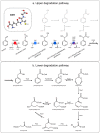On the Enigma of Glutathione-Dependent Styrene Degradation in Gordonia rubripertincta CWB2
- PMID: 29475871
- PMCID: PMC5930330
- DOI: 10.1128/AEM.00154-18
On the Enigma of Glutathione-Dependent Styrene Degradation in Gordonia rubripertincta CWB2
Abstract
Among bacteria, only a single styrene-specific degradation pathway has been reported so far. It comprises the activity of styrene monooxygenase, styrene oxide isomerase, and phenylacetaldehyde dehydrogenase, yielding phenylacetic acid as the central metabolite. The alternative route comprises ring-hydroxylating enzymes and yields vinyl catechol as central metabolite, which undergoes meta-cleavage. This was reported to be unspecific and also allows the degradation of benzene derivatives. However, some bacteria had been described to degrade styrene but do not employ one of those routes or only parts of them. Here, we describe a novel "hybrid" degradation pathway for styrene located on a plasmid of foreign origin. As putatively also unspecific, it allows metabolizing chemically analogous compounds (e.g., halogenated and/or alkylated styrene derivatives). Gordonia rubripertincta CWB2 was isolated with styrene as the sole source of carbon and energy. It employs an assembled route of the styrene side-chain degradation and isoprene degradation pathways that also funnels into phenylacetic acid as the central metabolite. Metabolites, enzyme activity, genome, transcriptome, and proteome data reinforce this observation and allow us to understand this biotechnologically relevant pathway, which can be used for the production of ibuprofen.IMPORTANCE The degradation of xenobiotics by bacteria is not only important for bioremediation but also because the involved enzymes are potential catalysts in biotechnological applications. This study reveals a novel degradation pathway for the hazardous organic compound styrene in Gordonia rubripertincta CWB2. This study provides an impressive illustration of horizontal gene transfer, which enables novel metabolic capabilities. This study presents glutathione-dependent styrene metabolization in an (actino-)bacterium. Further, the genomic background of the ability of strain CWB2 to produce ibuprofen is demonstrated.
Keywords: genomic island; glutathione S-transferase; glutathione in actinobacteria; horizontal gene transfer; hybrid gene cluster; microbial ibuprofen production; proteomics; styrene monooxygenase; transcriptomics; xenobiotic compounds.
Copyright © 2018 American Society for Microbiology.
Figures



References
-
- Tischler D. 2015. Microbial styrene degradation. Springer Verlag, Berlin, Germany.
-
- van Agteren MH, Keuning S, Janssen DB, Janssen JP, Oosterhaven J. 2010. Handbook on biodegradation and biological treatment of hazardous organic compounds. Environment and chemistry, vol 2 Springer, Dordrecht, The Netherlands.
-
- Tischler D, Kaschabek SR. 2012. Microbial styrene degradation: from basics to biotechnology, p 67–99. In Singh SN. (ed), Microbial degradation of xenobiotics. Springer-Verlag, Berlin, Germany.
Publication types
MeSH terms
Substances
LinkOut - more resources
Full Text Sources
Other Literature Sources
Molecular Biology Databases
Research Materials
Miscellaneous

